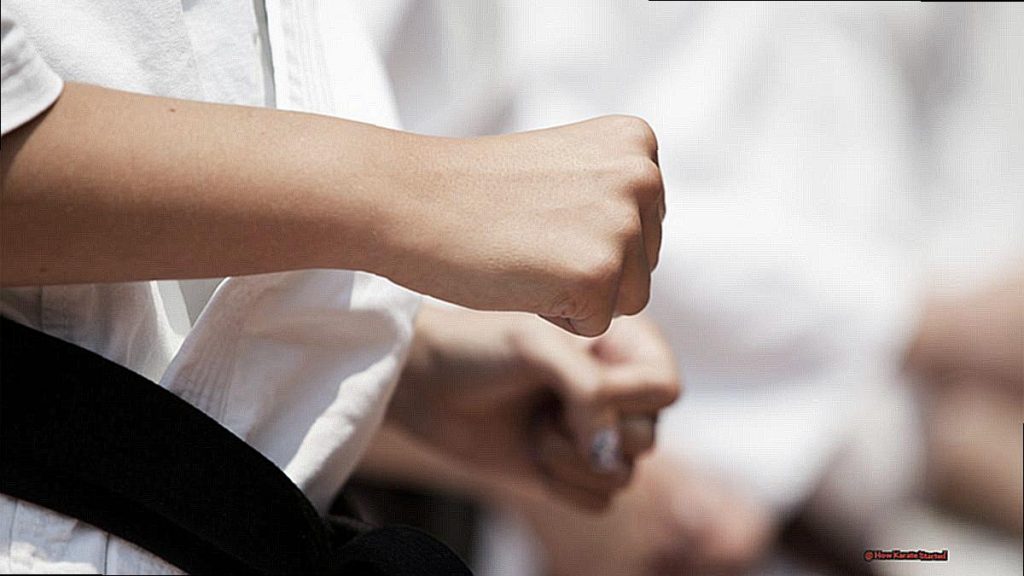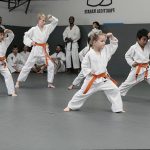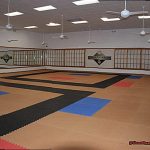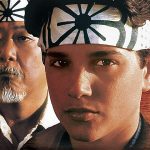Have you ever wondered how the powerful and precise movements of karate came to be? This ancient martial art has captivated people all over the world with its disciplined mindset and effective self-defense techniques.
But let’s rewind back in time to uncover the origins of karate:
- It all began on the small island of Okinawa, Japan, during the 14th century.
- Influenced by Chinese martial arts brought by Chinese families, karate was born.
- The name “karate” translates to “empty hand,” highlighting its focus on unarmed combat techniques.
- As it gained popularity, karate spread to mainland Japan and eventually reached other countries through dedicated masters and practitioners.
- Today, there are various styles of karate, including Shotokan, Goju-Ryu, and Wado-Ryu.
From its humble beginnings to becoming a global phenomenon, karate has come a long way. Beyond just a fighting style, it embodies discipline, respect, and inner strength. So join me as we dive into the captivating history of karate.
The Origins of Karate: Tracing Its Roots to Ancient China
The origins of karate can be traced back to ancient China, where it was known as Kung Fu. It was originally developed by an Indian monk named Bodhidharma, who recognized the importance of physical training in strengthening both the body and mind. Through cultural and economic exchanges, this training was introduced to the Ryukyu Kingdom, where it became known as “te” or “Tode.”
Over time, “te” evolved into different styles such as Shuri-te and Naha-te in Okinawa. In the late 19th century, Master Gichin Funakoshi brought “te” to mainland Japan and renamed it “karate.” Funakoshi also incorporated elements of Japanese martial arts, making it more accessible for Japanese students.
As karate gained popularity in Japan, it spread to other parts of the world. In the 1950s and 1960s, it became well-known in the United States through American soldiers stationed in Japan and Hollywood films featuring martial arts.
Today, karate is a widely practiced martial art with various styles and variations, each emphasizing different techniques and principles. From its origins in ancient China and Okinawa, karate has evolved into a global phenomenon, with millions of practitioners worldwide.
The Influence of Bodhidharma and the Development of “Te” in Okinawa
The teachings of Bodhidharma had a profound effect on the development of Te in Okinawa and played a crucial role in the origins of karate. His emphasis on discipline, mental focus, and physical training closely align with the core principles of karate, which were then incorporated into the existing fighting techniques of Te. This integration gave rise to a new style of martial arts called “To-De” or “Tang Hand,” which eventually evolved into traditional Okinawan karate. Moreover, Bodhidharma’s teachings also significantly influenced the philosophical foundations of karate, promoting inner strength, composure, and a harmonious balance between the mind, body, and spirit.
One notable example of Bodhidharma’s impact on the development of karate is his emphasis on self-discipline. In his teachings, he stressed the importance of controlling one’s mind and body to achieve a higher level of mastery. This principle resonated deeply with the practitioners of Te, who were already known for their strict discipline and rigorous training methods. As a result, Bodhidharma’s teachings were seamlessly integrated into the practice of Te, adding a new layer of depth to its already formidable techniques.
Additionally, Bodhidharma’s emphasis on mental focus was also highly influential in the development of karate. His teachings emphasized the importance of clear and focused thinking in combat situations, which aligned perfectly with the fast-paced nature of karate. By incorporating this idea into their training, practitioners of Te were able to enhance their mental acuity and improve their performance in combat.
Bodhidharma’s teachings also had a significant impact on the philosophical underpinnings of karate. His emphasis on inner strength and the balance of mind, body, and spirit laid the foundation for the spiritual aspect of karate that is still present today. Through his teachings, he instilled in practitioners the importance of developing not just physical strength but also mental fortitude and spiritual resilience.
The Evolution from “Te” to Karate: Master Gichin Funakoshi’s Impact
Master Gichin Funakoshi played a pivotal role in the transformation of te into the martial art known as karate. His influence can be observed in the development of Shotokan, his own unique style of karate that gained widespread recognition and spread globally.
Funakoshi’s journey began at the age of 11 when he was first introduced to the Okinawan art of te. He trained under two prominent masters, Azato and Itosu, and honed his skills in all the major styles of karate on the island. His unwavering dedication and exceptional abilities ultimately led him to create his own method, which he called Shotokan. This style was a fusion of the various techniques he had acquired throughout his training.
In 1916, Funakoshi showcased his skills in a karate demonstration at the Butokuden in Kyoto, the official center for all martial arts in Japan at that time. This event marked the first public appearance of karate on mainland Japan. Five years later, he was invited to demonstrate his art for the Crown Prince of Japan, and later traveled to Tokyo to perform at a national exhibition organized by the Ministry of Education.
Funakoshi’s teachings emphasized that karate was not just a physical practice, but also a way of life. He coined the term “karate-do,” which translates to “the way of karate,” to highlight its significance as an education for life. Through his teachings and demonstrations, Funakoshi popularized karate in Japan and eventually across the globe.
His impact is also evident in the naming of his style as Shotokan, derived from his pen name “Shoto.” This name continues to be used today when referring to one of the most renowned styles of karate.
| Contributions | Description |
| Creation of Shotokan | Funakoshi’s unique style of karate, a fusion of various techniques that gained widespread recognition and spread globally. |
| First public appearance of karate in Japan | In 1916, Funakoshi showcased karate at the Butokuden in Kyoto, marking its first public appearance on mainland Japan. |
| Introduction to the Crown Prince of Japan | In 1921, Funakoshi was invited to demonstrate his art for the Crown Prince of Japan, further solidifying the popularity of karate in the country. |
| Emphasis on karate as a way of life | Funakoshi coined the term “karate-do,” highlighting its importance not just as a physical practice, but also as an education for life. |
| Naming of Shotokan |
Karate’s Introduction to Mainland Japan and Its Spread Across the Globe
Karate was first introduced to mainland Japan in the early 20th century, thanks to the dedication of three pioneers – Gichin Funakoshi, Kenwa Mabuni, and Chojun Miyagi. These individuals were instrumental in bringing karate to the public eye and making it popular not only in Japan but also around the world.
In 1922, a group of Okinawan karate masters, including Funakoshi, performed for the Japanese Emperor, showcasing their skills and drawing attention to this previously obscure martial art. This event marked the official introduction of karate to mainland Japan.
Funakoshi, often known as the “father of modern karate,” played a crucial role in spreading karate to the masses. He established the Shotokan style and emphasized its philosophical aspects, promoting it as more than just a means of self-defense.
Another influential figure in promoting karate was Kenwa Mabuni, who founded the Shito-Ryu style. Along with Funakoshi, he was one of the first Okinawan masters to openly teach karate in mainland Japan.
Chojun Miyagi, who developed the Goju-Ryu style, also played a significant role in spreading karate in mainland Japan and beyond. He made several trips to China to expand his knowledge and incorporated Chinese martial arts techniques into his style.
Despite being banned during World War II, karate continued to spread throughout Japan through underground training and eventually gained global popularity. Today, there are numerous styles of karate practiced worldwide, each with its unique techniques and philosophy.
In conclusion, the efforts of these pioneers and their demonstrations helped introduce karate to mainland Japan and paved the way for its global spread.
The Popularity of Karate in Post-WWII America and Hollywood’s Role
Hollywood played a pivotal role in making karate popular in post-WWII America, thanks to its portrayal of the martial art in films and TV shows.
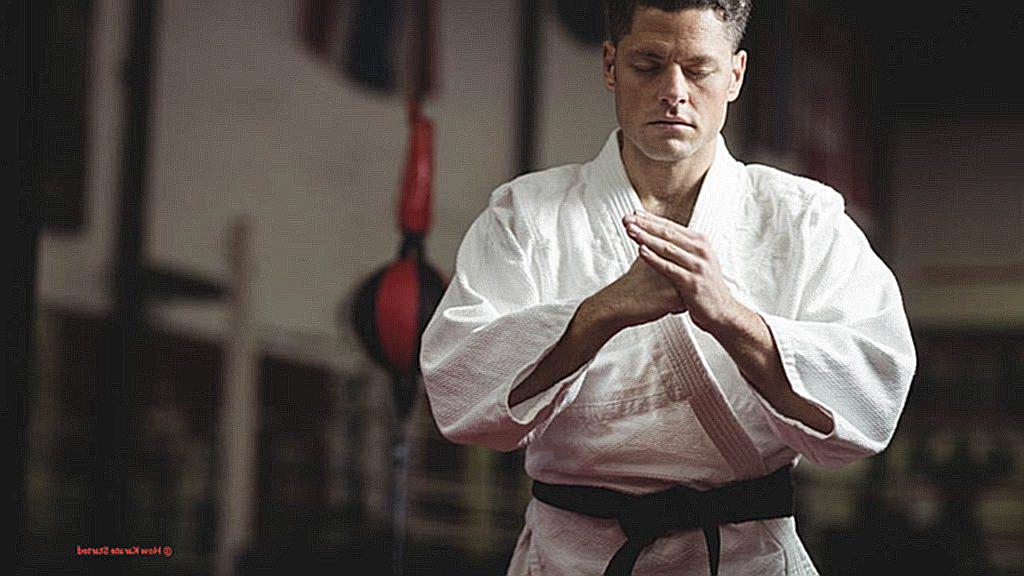
Films featuring karate:
- Starting in the 1950s and 1960s, Hollywood began incorporating karate into its action movies, with blockbusters like “The Karate Kid” and “Enter the Dragon” captivating audiences.
- These movies not only showcased the physical prowess and discipline of karate, but also highlighted its spiritual and philosophical elements, making it more appealing to a wider audience.
- The success of these films sparked a surge of interest in karate, resulting in a rise in the number of dojos (karate training centers) across America.
Television shows:
- Hollywood’s fascination with karate extended to television shows as well, with prime-time series such as “Kung Fu” and “The Master” featuring main characters who were skilled practitioners of the martial art.
- These shows solidified the image of karate as a potent and honorable martial art, inspiring many viewers to take up the practice themselves.
Celebrity endorsements:
- As Hollywood stars openly endorsed karate, its popularity continued to soar as fans sought to emulate their favorite actors and actresses.
- Celebrities like Chuck Norris, who held black belts in various martial arts including karate, became household names and helped raise awareness about the practice.
International influence:
- With Hollywood’s global reach, its depiction of karate also had a significant impact on its popularity in other countries, leading to its spread across Europe, Asia, and beyond.
- Hollywood’s portrayal of karate as a cool and powerful martial art helped break down cultural barriers and make it more accessible to people from different backgrounds.
So, Hollywood’s portrayal of karate as an exciting and formidable martial art played a critical role in its popularity in post-WWII America. Through films, television shows, and celebrity endorsements, Hollywood introduced karate to a wider audience and inspired many to take up the practice.
Different Styles and Variations of Karate Practiced Today
When it comes to the different styles and variations of karate practiced today, there are two main schools of thought: traditional and modern. Each style has its own unique approach, techniques, and focus that sets it apart from the other.
Traditional karate has a strong emphasis on defensive techniques, drawing heavily from its ancient Chinese roots. This style also places great importance on forms, or kata, which are used for both self-development and as a way to honor the art’s history. On the other hand, modern karate is all about flash and competition, incorporating offensive techniques and elements from other martial arts to create a more fast-paced and visually appealing form of the sport.
While traditional karate focuses on developing oneself spiritually and philosophically through the practice of budo (the martial way), modern karate is geared more towards physical fitness and competition. However, both styles have their own unique merits and can provide practitioners with different benefits. It ultimately comes down to personal preference and goals when choosing between the two.
Traditional karate emphasizes the spiritual and philosophical aspects of the martial art, while modern karate puts more emphasis on physicality and competition.
Principles and Techniques of Karate: A Way of Life for Many Practitioners
Karate is not just a form of martial arts, but a way of life for many who practice it. Its principles and techniques go beyond physical training and are deeply ingrained in the practice, guiding practitioners not only in their movements but also in their mindset and approach to life.
The following table highlights the key principles of karate and their significance:
| Principle | Description |
| Rei (Respect) | Karate begins and ends with the principle of respect, symbolized by bowing. This teaches practitioners to show respect towards their instructors, fellow students, themselves, and others in all aspects of life. |
| Justice | In karate, there is no room for aggression. This principle upholds the idea of using martial arts for good and standing up for justice. |
| Self-Knowledge | To understand others, one must first know oneself. This principle emphasizes the importance of introspection and self-reflection in personal growth. |
| Mentality over Technique | In karate, mental strength takes precedence over physical technique. This highlights the importance of having a strong mindset and staying focused even in challenging situations. |
| Freedom of the Heart | Karate teaches practitioners to let go of negative emotions and approach situations with an open heart. This principle emphasizes the importance of controlling one’s emotions. |
| Carefulness | The principle of “calamity springs from carelessness” reminds practitioners to be mindful and careful in their actions, both inside and outside the dojo. |
| Beyond the Dojo | Karate is not confined to physical training, but rather its principles can be applied to everyday life. This encourages practitioners to take what they learn in the dojo and apply it to all aspects of their lives. |
| Wisdom | The knowledge gained from karate should be used wisely. This principle reminds practitioners to use their skills and abilities for good and avoid using them for harm or aggression. |
| Perfection of Character | A central tenet of karate is striving towards perfection of character, both physically and mentally. This emphasizes the importance of constantly working towards self-improvement. |
| Best Effort | In karate, one must always give their best effort. This principle teaches practitioners to never give up and always strive for excellence. |
Conclusion
In conclusion, the mesmerizing and precise techniques of karate have captured the hearts of people worldwide. This ancient martial art originated on the small island of Okinawa, Japan in the 14th century and was heavily influenced by Chinese martial arts. The name “karate” translates to “empty hand,” emphasizing its focus on unarmed combat.
As it gained popularity, karate spread to mainland Japan and eventually reached other countries through dedicated masters and practitioners. Today, there are various styles of karate, each with its own unique principles and techniques. From traditional styles that prioritize spiritual and philosophical development to modern styles focused on physical fitness and competition, karate offers something for everyone.
But beyond just a fighting style, karate embodies discipline, respect, and inner strength. Its principles extend beyond the dojo and can be applied to everyday life, making it a way of life for many practitioners. From its humble beginnings to becoming a global phenomenon, karate has come a long way. Its evolution from ancient China to modern-day America is a testament to its enduring appeal and influence.
So, whether you’re seeking self-defense skills or a path towards personal growth, join the millions of individuals around the world who have been captivated by the rich history of karate. Let this powerful martial art inspire you to push your limits and discover your inner strength.

